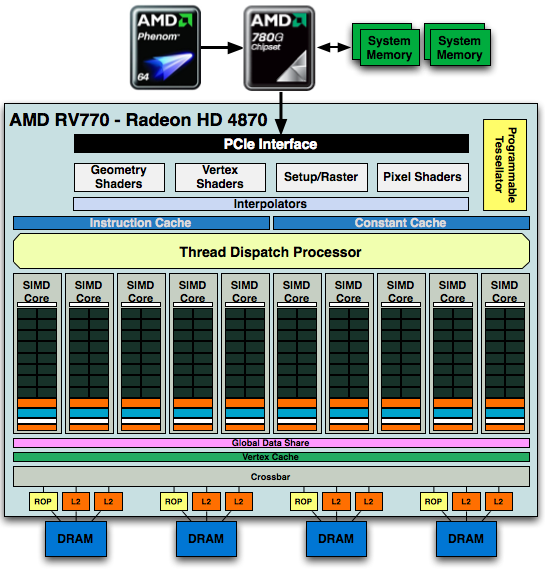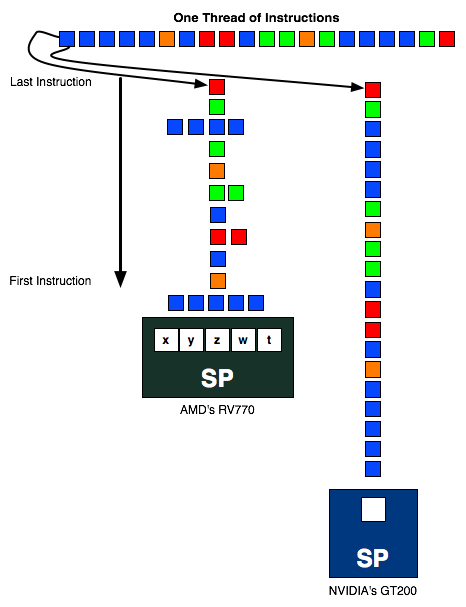AMD's Radeon HD 5870: Bringing About the Next Generation Of GPUs
by Ryan Smith on September 23, 2009 9:00 AM EST- Posted in
- GPUs
A Quick Refresher on the RV770
As Cypress is a direct evolution of the RV770 design, before we talk about what’s new with Cypress we are going to go over a quick rehash of RV770’s internal workings. As it’s necessary to understand how RV770 was built to understand what Cypress changes, if you’re completely unfamiliar with RV770, please take a look at our expanded discussion of RV770 from last year. For the rest of you, let’s get started.
At the center of the RV770 is the Stream Processing Unit (SPU), a single arithmetic logic unit. The RV770 has 800 of these, and they are packaged together in groups of 5 and are what we call a Streaming Processor (SP). A SP contains a register file, a branch predictor, and the aforementioned 5 SPUs, with the 5th SPU being a more complex unit capable of transcendental functions along with the base functions of an ALU. The SP is the smallest unit that can do individual work; every SPU in an SP must execute the same instruction.

For every 16 SPs, AMD groups them together with texture units, L1 cache, shared memory, and controlling logic. This combined block is what AMD calls a SIMD, and RV770 has 10 of them. These 10 SIMDs form the core computational power of the RV770, and in the chip work with various specialized units such as ROPs, rasterizers, L2 cache, and tesselators to form a complete chip.

To utilize the computational power of the hardware, instruction threads are issued to the SPs. These threads are grouped into wavefronts, where there are 64 threads per wavefront. To maximize the utilization of the GPU, threads need to be organized so that they can feed all 5 SPUs in a SP an instruction every clock cycle. Doing this requires extracting instruction level parallelism (ILP) out of programs being passed to the GPU, which is difficult task of AMD’s compiler.
If SPUs go unused, then the performance of the chip suffers due to underutilization. This design gives AMD a great deal of theoretical computational power, but it is always a challenge to fully exploit it.











327 Comments
View All Comments
Wreckage - Wednesday, September 23, 2009 - link
Hot, loud, huge power draw and it barely beats a 285.A disappointment for sure.
SiliconDoc - Thursday, September 24, 2009 - link
Thank you Wreckage, now, I was going to say draw up your shields, but it's too late, the attackers have already had at it.--
Thanks for saying what everyone was thinking. You are now "a hated fanboy", "a paid shill" for the "corporate greedy monster rip off machine", according to the real fanboy club, the ones who can't tell the truth, no matter what, and prefer their fantasiacal spins and lies.
Zstream - Wednesday, September 23, 2009 - link
They still allow you to post?yacoub - Wednesday, September 23, 2009 - link
He's right in the first sentence but went all fanboy in the second.Griswold - Wednesday, September 23, 2009 - link
Not really, he's a throughbred fanboy with everything he said. Even on the "loud" claim compared to what previous reference designs vom ATI were like...SiliconDoc - Wednesday, September 30, 2009 - link
So if YOU compare one loud design of ati's fan to another fan and as loud ati card( they're all quieter than 5870* but we'll make believe for you for now),
and they're both loud, anyone complaining about one of them being loud is "an nvidia fanboy" because he isn't aware of the other loud as heck ati cards, which of course, make another loud one "just great" and "not loud". LOL
It's just amazing, and if it was NV:
" This bleepity bleep fan and card are like a leaf blower again, just like the last brute force monster core power hog but this **tard is a hurricane with no eye."
But since it's the red cards that are loud, as YOU pointed out in the plural, not singular like the commenter, according to you HE's the FANBOY, because he doesn't like it. lol
ULTIMATE CONCLUSION: The commenter just told the truth, he was hoping for more, but was disappointed. YOU, the raging red, jumped his case, and pointed out the ati cards are loud "vom" prior.. and so he has no right to be a big green whining fanboy...
ROFLMAO
I bet he's a "racist against reds" every time he validly criticizes their cards, too.
---
the 5870 is THE LOUDEST ATI CARD ON THE CHART,AND THE LOUDEST SINGLE CORE CARD.
--
Next, the clucking rooster will whiplash around and flap the stubby wings at me, claiming at idle it only draws 27 watts and is therefore quiet.
As usual, the sane would them mention it will be nice not playing any 3d games with a 3d gaming card, and enjoying the whispery hush.
--
In any case:
Congratulations, you've just won the simpleton's red rooster raving rager thread contest medal and sarcastic unity award.(It's as real as any points you've made)
Anyhow thanks, you made me notice THE 5870 IS THE LOUDEST CARD ON THE CHARTS. I was too busy pointing out the dozen plus other major fibboes to notice.
It's the loudest ati card, ever.
GourdFreeMan - Wednesday, September 23, 2009 - link
I thought the technical portion of your review was well written. It is clear, concise and written to the level of understanding of your target audience. However, I am less than impressed with your choice of benchmarks. Why is everything run at 4xAA, 16xAF? Speaking for most PC gamers, I would have maxed the settings in Crysis Warhead before adding AA and AF. Also, why so many console ports? Neither I, nor anyone else I personally know have much interest in console ports (excluding RPGs from Bethesda). Where is Stalker: Clear Sky? As you note its sequel will be out soon. Given the short amount of time they had to work with DX11, I imagine it will run similarly to Stalker: Call of Pripyat. Also, where is ArmA II? Other than Crysis and Stalker it is the game most likely to be constrained by the GPU.I don't want to sound conspiratorial, but your choice of games and AA/AF settings closely mirror AMD's leaked marketing material. It is good that you put their claims to the test, as I trust Anandtech as an unbiased review site, but I don't think the games you covered properly cover the interests of PC gamers.
Ryan Smith - Wednesday, September 23, 2009 - link
For the settings we use, we generally try to use the highest settings possible. That's why everything except Crysis is at max quality and 4xAA 16xAF (bear in mind that AF is practically free these days). Crysis is the exception because of its terrible performance; Enthusiast level shaders aren't too expensive and improve the quality more than anything else, without driving performance right off a cliff. As far as playing the game goes, we would rather have AA than the rest of the Enthusiast features.As for our choice of games, I will note that due to IDF and chasing down these crazy AA bugs, we didn't get to run everything we wanted to. GRID and Wolfenstein (our OpenGL title) didn't make the cut. As for Stalker, we've had issues in the past getting repeatable results, so it's not a very reliable benchmark. It also takes quite a bit of time to run, and I would have had to drop (at least) 2 games to run it.
Overall our game selection is based upon several factors. We want to use good games, we want to use popular games so that the results are relevant for the most people, we want to use games that give reliable results, and ideally we want to use games that we can benchmark in a reasonable period of time (which means usually having playback/benchmark tools). We can't cover every last game, so we try to get what we can using the criteria above.
GourdFreeMan - Thursday, September 24, 2009 - link
Popularity and quality are strong arguments for World of Warcraft, Left 4 Dead, Crysis, Far Cry, the newly released Batman game... and *maybe* Resident Evil (though it is has far greater popularity among console gamers). However, HAWX? Battleforge? I would never have even heard of these games had I not looked them up on Wikipedia. In retrospect I can see you using Battleforge due to it being the only DirectX 11 title, but I still don't find your list of games compelling or comprehensive.To me *PC* gaming needs to offer something more than simple action to justify its cost of entry. In the past this included open worlds, multiplayer, greater graphical realism and attempts at balancing realistic simulation with entertaining game play. Console gaming has since offered the first two, but the latter are still lacking.
It's games like Crysis, Stalker and ArmA II along with the potential of modding that attract people to PC gaming in the first place...
dvijaydev46 - Wednesday, September 23, 2009 - link
Good review but it would be good if you could also add Steam and Cuda benchmarks. Now you have a common software Mediashow Espresso right?